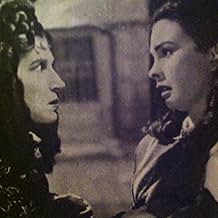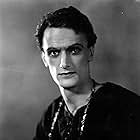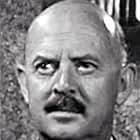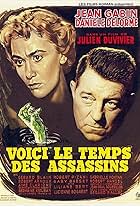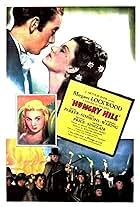Following her father's death, a teenage British heiress goes to live with her guardian uncle--who is broke and schemes to murder her for her inheritance.Following her father's death, a teenage British heiress goes to live with her guardian uncle--who is broke and schemes to murder her for her inheritance.Following her father's death, a teenage British heiress goes to live with her guardian uncle--who is broke and schemes to murder her for her inheritance.
- Director
- Writers
- All cast & crew
- Production, box office & more at IMDbPro
Storyline
Did you know
- GoofsThe length of Jean Simmons' ringlets change from one shot to the other.
- Quotes
Uncle Silas Ruthyn: And here you are! One of my hopes fulfilled.
- Alternate versionsThe American release, under the title, "The Inheritance" is six minutes shorter than the original British version, titled "Uncle Silas," after the film's source novel.
- ConnectionsVersion of El misterioso tío Sylas (1947)
- SoundtracksMy Hat, It Has Three Corners
(uncredited)
American traditional song
Played in the background during the scene in the London hotel.
Featured review
Historical melodrama ("The Man in Grey", "The Wicked Lady", "Jassy", "Blanche Fury") was a popular genre in the British cinema of the forties, and "Uncle Silas", based upon a novel by Sheridan Le Fanu, is another example. (These films had their equivalents in the American cinema, such as "Dragonwyck"). The action takes place in the mid 19th century. The heroine, Caroline Ruthyn is a sixteen-year-old heiress. When her widowed father dies, his will appoints his younger brother Silas as her guardian. In his youth Silas had a reputation as a rake, but now everyone believes him to be a reformed character. The truth, however, is that he has only abandoned his debauched lifestyle because of failing health and dwindling finances, not because of a genuine change of heart. He greets Caroline warmly, but his affection for her is only feigned, and he is secretly plotting to get his hands on her fortune.
Some melodramas from this period, such as "Jassy" and "Blanche Fury", were made in colour, and can be seen as predecessors of the more recent "heritage cinema" movement. "Uncle Silas", however, was made in black-and-white, possibly to emphasise the Gothic elements of the story. It mostly lacks the element of bodice-ripping sexual passion which is strongly implied, if not always made explicit, in films like "The Man in Grey" or "The Wicked Lady". The only character who is chiefly motivated by sexual desire is Silas's dissolute son Dudley and his passion, for his cousin Caroline, is not returned. (Far from it. Caroline loathes Dudley and has no illusions about his true nature, even though she is still under an illusion about the true nature of his father Silas).
There are certain similarities between this film and the American-made "Dragonwyck", made the previous year. Both were set at around the same period in history and both feature a beautiful, innocent brunette heroine (Jean Simmons here, Gene Tierney in "Dragonwyck") who goes to live with a sinister relative in a gloomy Gothic mansion. There is an obvious contrast between the spacious, airy Georgian stately home which Caroline inherits from her father and Silas's ramshackle, tumbledown mediaeval or Tudor manor house. (As an impoverished younger son, he presumably cannot afford anything more commodious). At first the girl is deceived as to her relative's character- in "Dragonwyck" the heroine, Miranda, even goes so far as to marry her distant cousin Nicholas- but his true nature eventually emerges and she finds herself in danger.
The difference between this film and "Dragonwyck" lies in the way it is acted. As another reviewer has pointed out the good characters- Caroline, her father and her admirer Lord Richard Ilbury- are all played straight, whereas the evil ones- Silas, Dudley and their sidekick, Caroline's former governess, Madame de la Rougierre- are all to some extent melodramatic caricatures. The main villain in "Dragonwyck", Nicholas, is not caricatured in this way. Katina Paxinou as Madame de la Rougierre perhaps goes too far over the top, and Dudley, whose role is not a large one, is a sort of bargain-basement Squire Jasper. Derrick De Marney, however, makes a splendid villain as Silas. He was only in his early forties in 1947, but looks much older, and it is difficult to believe that he is the same man who had played the handsome young male lead in Hitchcock's "Young and Innocent" only a decade earlier. On the virtuous side, Simmons makes a luminously lovely heroine, and there is a good performance from Reginald Tate as Caroline's father Austin. The devoutly Christian Austin Ruthyn is a good man, but suffers from a character defect common among good people- he is so noble and upright that he cannot understand, or even conceive of the existence of, anyone who is less noble and upright than himself.
Today, melodramas like this one can come across as dated, with their exaggerated emotion and exaggeratedly black-and-white view of the world, represented here by the contrast between the good and the evil characters. Barbara and the saintly Caroline. Yet to anyone prepared to make allowances for the differences between contemporary tastes and those of seventy years ago, a film like "Uncle Silas" can be seen as a fine example of a once-fashionable style of film-making. 7/10.
Some melodramas from this period, such as "Jassy" and "Blanche Fury", were made in colour, and can be seen as predecessors of the more recent "heritage cinema" movement. "Uncle Silas", however, was made in black-and-white, possibly to emphasise the Gothic elements of the story. It mostly lacks the element of bodice-ripping sexual passion which is strongly implied, if not always made explicit, in films like "The Man in Grey" or "The Wicked Lady". The only character who is chiefly motivated by sexual desire is Silas's dissolute son Dudley and his passion, for his cousin Caroline, is not returned. (Far from it. Caroline loathes Dudley and has no illusions about his true nature, even though she is still under an illusion about the true nature of his father Silas).
There are certain similarities between this film and the American-made "Dragonwyck", made the previous year. Both were set at around the same period in history and both feature a beautiful, innocent brunette heroine (Jean Simmons here, Gene Tierney in "Dragonwyck") who goes to live with a sinister relative in a gloomy Gothic mansion. There is an obvious contrast between the spacious, airy Georgian stately home which Caroline inherits from her father and Silas's ramshackle, tumbledown mediaeval or Tudor manor house. (As an impoverished younger son, he presumably cannot afford anything more commodious). At first the girl is deceived as to her relative's character- in "Dragonwyck" the heroine, Miranda, even goes so far as to marry her distant cousin Nicholas- but his true nature eventually emerges and she finds herself in danger.
The difference between this film and "Dragonwyck" lies in the way it is acted. As another reviewer has pointed out the good characters- Caroline, her father and her admirer Lord Richard Ilbury- are all played straight, whereas the evil ones- Silas, Dudley and their sidekick, Caroline's former governess, Madame de la Rougierre- are all to some extent melodramatic caricatures. The main villain in "Dragonwyck", Nicholas, is not caricatured in this way. Katina Paxinou as Madame de la Rougierre perhaps goes too far over the top, and Dudley, whose role is not a large one, is a sort of bargain-basement Squire Jasper. Derrick De Marney, however, makes a splendid villain as Silas. He was only in his early forties in 1947, but looks much older, and it is difficult to believe that he is the same man who had played the handsome young male lead in Hitchcock's "Young and Innocent" only a decade earlier. On the virtuous side, Simmons makes a luminously lovely heroine, and there is a good performance from Reginald Tate as Caroline's father Austin. The devoutly Christian Austin Ruthyn is a good man, but suffers from a character defect common among good people- he is so noble and upright that he cannot understand, or even conceive of the existence of, anyone who is less noble and upright than himself.
Today, melodramas like this one can come across as dated, with their exaggerated emotion and exaggeratedly black-and-white view of the world, represented here by the contrast between the good and the evil characters. Barbara and the saintly Caroline. Yet to anyone prepared to make allowances for the differences between contemporary tastes and those of seventy years ago, a film like "Uncle Silas" can be seen as a fine example of a once-fashionable style of film-making. 7/10.
- JamesHitchcock
- Jun 16, 2021
- Permalink
Details
Box office
- Budget
- $1,000,000 (estimated)
- Runtime1 hour 38 minutes
- Color
- Aspect ratio
- 1.37 : 1
Contribute to this page
Suggest an edit or add missing content









